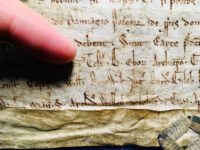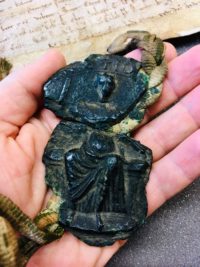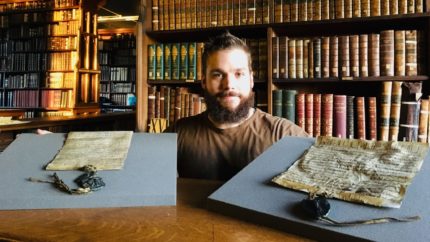 An original royal charter from the reign of King John has been discovered in Durham University’s Ushaw College Library. Dr. Benjamin Pohl, a medieval history professor from the University of Bristol, found the rare document while studying the library’s medieval manuscripts with archivist Dr. Jonathan Bush. As they went through the library’s extensive collection of manuscripts, they discovered a box in the safe with documents that had not been officially catalogued; the royal charter was among them.
An original royal charter from the reign of King John has been discovered in Durham University’s Ushaw College Library. Dr. Benjamin Pohl, a medieval history professor from the University of Bristol, found the rare document while studying the library’s medieval manuscripts with archivist Dr. Jonathan Bush. As they went through the library’s extensive collection of manuscripts, they discovered a box in the safe with documents that had not been officially catalogued; the royal charter was among them.
The charter dates to 1200, the first year of King John’s reign and was issued in York on March 26th making it exactly (almost to the day) 819 years old. In it the King confirms the grant of two hamlets — Cornsay and Hedley Hill in County Durham — to Walter of Caen and Robert FitzRoger. FitzRoger was Lord of Warkworth and Sherriff of Norfolk and Suffolk, and both men were the nephews of Simon, a chamberlain of Durham who had received the hamlets more than 15 years earlier as a grant from the Bishop of Durham Hugh de Puiset. Simon wanted to give the hamlets to his nephews but needed the king’s royal charter to make the grants legal and official.
 There may have been a undercurrent of political clean-up here too. Hugh de Puiset was thoroughly enmeshed in the turbulent monarchy of Stephen of Blois through the Angevin rulers. He was Stephen’s nephew, either sided against Henry II during his sons’ revolt against him or at least operated shadily in the background against the king. Hugh bought important offices from King Richard for a pretty penny, and when Prince John took control of the throne during Richard’s captivity in Vienna, Hugh opposed him to the point of battle, sending troops against some of John’s properties in the north of England in 1193. Hugh de Puiset died in 1195. John became King of England on May 27th, 1199. Ten months later, John granted Hugh’s nephews the properties his erstwhile enemy had given them.
There may have been a undercurrent of political clean-up here too. Hugh de Puiset was thoroughly enmeshed in the turbulent monarchy of Stephen of Blois through the Angevin rulers. He was Stephen’s nephew, either sided against Henry II during his sons’ revolt against him or at least operated shadily in the background against the king. Hugh bought important offices from King Richard for a pretty penny, and when Prince John took control of the throne during Richard’s captivity in Vienna, Hugh opposed him to the point of battle, sending troops against some of John’s properties in the north of England in 1193. Hugh de Puiset died in 1195. John became King of England on May 27th, 1199. Ten months later, John granted Hugh’s nephews the properties his erstwhile enemy had given them.
Very few original charters from John’s first year of kingship have survived. They are usually known from charter rolls (administrative records of all royal charters) and some contemporary copies that were spread around the country and kept in institutional archives. This royal charter is all the more important because it is only known from the charter roll and there are differences between it and the administrative record. Some are minor differences — spelling mostly — but one is a very notable discrepancy in the list of witnesses. The charter roll only records the Archbishop of York, the Chief Justiciar of England and the Sheriff of Yorkshire and Northumberland as witnesses present at the issue of the charter on March 26th, 1200. The original charter has a much longer list of witnesses, adding the Constable of Chester, the Sheriff of Berkshire, Cornwall and Devon, the Royal Justice and Baron of the Exchequer, the Lord of Kendal, one Germanus Tison and Henry, son of the Archbishop of York, to the ones named in the charter roll.
Dr Pohl said: “Discovering the original charter at Ushaw is extremely exciting, not least because it allows us to develop a fuller picture of the people who were present at York on 26 March 1200 and eager to do business with the new king.
“Medieval charters are important not just because of the legal acts they contain, but also for what they can tell us about the society and political culture at the time. Indeed, their issuing authorities, beneficiaries and witnesses provide a cross section of medieval England’s ruling elites.
“Our charter might best be described, therefore, as a kind of ‘who’s who’ of Northern England (and beyond) at the turn of the thirteenth century.”
And then some. The Durham Residential Research Library collection also includes the original charter in which Hugh de Puiset granted Simon the two hamlets. The discovery of the royal charter allows scholars to compare the two documents side-by-side.
